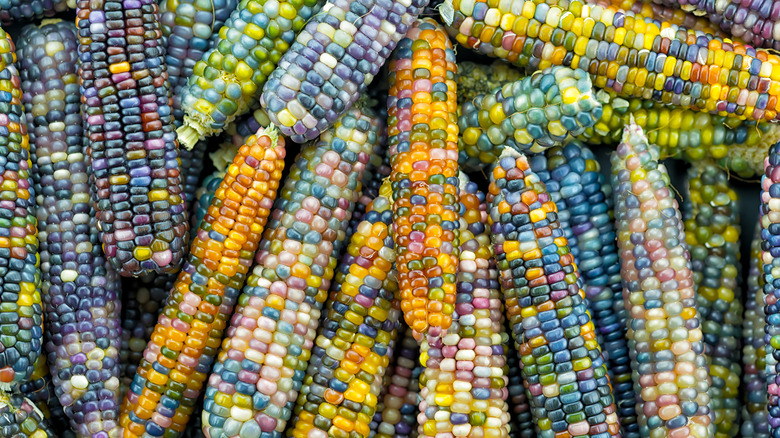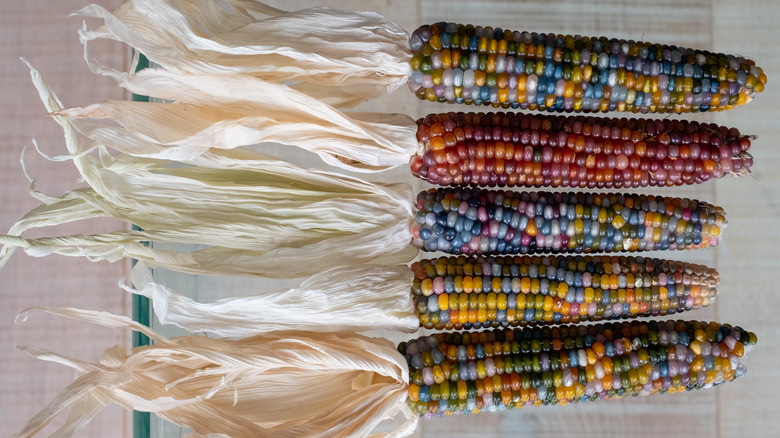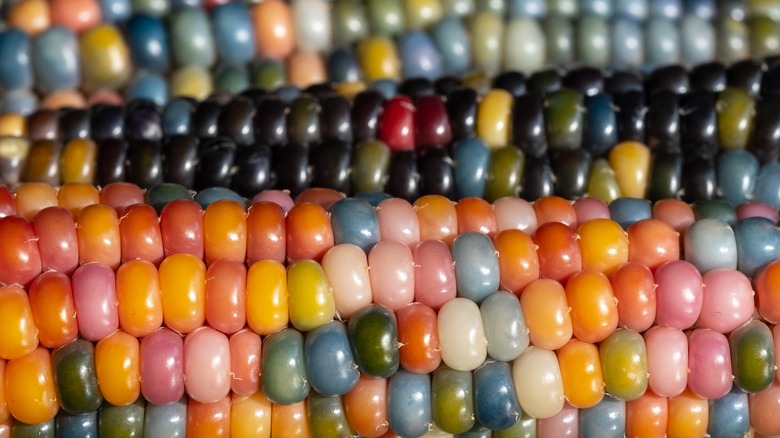What Makes Glass Gem Corn Unique?
The story of glass gem corn is part history, part aesthetics, part preserving biodiversity and seed stores, and a whole lot of social media photos. Corn, in general, is a big topic. The National Agricultural Statistics Service, part of the United States Department of Agriculture (USDA), points out that in 2021, 15.1 billion bushels of corn were produced in the U.S. alone. That's a lot of kernels.
The College of Food, Agricultural, and Environmental Sciences at Ohio State University explains there are six basic types of corn, each with different properties and uses. Sweet corn is the kind we eat, and it's bred to be, well, sweet. It's harvested young, so the kernels are tender and delicious to eat. Dent corn or field corn is much higher in starch and is used for animal feed and ethanol production. Pod corn is the predecessor of modern corn and grows wild. Flour corn is full of starch and grinds easily, and popcorn is pretty self-explanatory. The final major category is flint corn, and it has several uses. One of which is ornamental because the brightly colored kernels make lovely fall decor.
What kind of corn is glass gem corn?
Glass gem corn is a kind of flint corn developed specifically to be beautiful, with what Native Seeds Search calls, "Gorgeous translucent, jewel-colored ears, each one unique." Though glass gem corn is beautiful and useful for several kitchen applications, you wouldn't pick an ear and eat it like sweet corn. Why not? Because it's hard as flint. Delighted Cooking explains that, in general, flint corn can range in color from white to black, with all the hues in between. The usable, starchy portion of each corn kernel is covered by a thick, hard shell, which has to be removed or processed before the flint corn can be eaten.
And how is glass gem corn eaten? The simplest and most fun way to enjoy it is to use the dried kernels to make popcorn, either the old-fashioned way on the stovetop or in the microwave. Dried kernels of glass gem corn can also be ground to make cornmeal or polenta. Kernels can be soaked in a solution containing either lye or baking soda to loosen the kernels' outer shells and make hominy, which Delighted Cooking tells us is the base for masa harina, a corn flour that's used to make tortillas and tortilla chips.
What is it, though, that makes glass gem corn special and different from other kinds of flint corn? How was it cultivated?
The Native American connection to glass gem corn
Carl Barnes spearheaded the birth of glass gem corn sometime in the 1940s as he was collecting different types of corn (per The Independent). The story is that Barnes was inspired by his part Cherokee heritage. He collected seeds from brightly-colored corn and, according to Insider, collected Native American varieties. He traded with other collectors of heirloom corn to preserve and protect some ancient varieties. He bred corn, specifically saving the most brightly colored kernels for replanting, shaping his selection, so it grew ever brighter. Barnes handed off some of his precious seeds to protégé Greg Schoen, telling him the original cross was a combination of one Pawnee and two Osage corn varieties. Schoen, in turn, refined the corn to make the kernels more translucent before handing seeds for preservation off to Bill McDorman, formerly of Native Seeds Search.
There's a bit of a wrinkle, though. If you want to purchase glass gem corn seeds to grow at home (which isn't terribly difficult, by the way). You'll find plenty of options, nearly all of which mention the Native American heritage of Carl Barnes. Rare Seeds is a good example. The site describes the corn as: "Bred from a number of Native varieties by Carl 'White Eagle' Barnes, the famous Cherokee corn collector to whom we owe our gratitude for his life's work of collecting, preserving, and sharing so many Native corn varieties." What's the trouble, then?
Turns out, we're not sure if Carl Barnes was really part Cherokee
The Alliance of Native Seedkeepers is an organization dedicated to preserving the culture and ensuring food security of indigenous people. As part of its mission, the organization operates using a "Non-Embellishment of Seed Origin Pledge," meaning it seeks to combat cultural misappropriation. The Alliance claims that Carl Barnes wasn't part Cherokee; a claim that is contradicted by other sources such as NPR, Garden Design, and Insider. However, the Alliance does note that the work Barnes did in developing glass gem corn is remarkable, and the corn should be enjoyed for its beauty.
Tasting Table reached out to the Cherokee Nation, which doesn't comment on Cherokee Nation citizenship status. However, a representative of the Nation told Tasting Table that Carl "White Eagle" Barnes, who passed away in 2016, was " ... a valued Friend and resource for the CN and instrumental in forming the CN's SeedBank." Regardless of his ancestry, Barnes created a magnificent variety of corn.
According to Den Garden, in 2008, Greg Schoen started sharing his glass gem corn seeds, and it was in 2012 that a photo of the corn went viral. Folks clamored for the seeds, which were hard to find and obtain. Now there are plenty of sources for glass gem corn, and it can be grown at home or purchased at markets, either for display or for use in recipes like classic corn tortillas.



